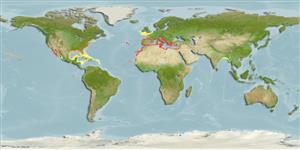Preferred temperature (Ref.
123201): 13.1 - 23, mean 15.8 °C (based on 226 cells).
Phylogenetic diversity index (Ref.
82804): PD
50 = 0.5005 [Uniqueness, from 0.5 = low to 2.0 = high].
Bayesian length-weight: a=0.01000 (0.00244 - 0.04107), b=3.04 (2.81 - 3.27), in cm total length, based on all LWR estimates for this body shape (Ref.
93245).
Trophic level (Ref.
69278): 3.5 ±0.45 se; based on food items.
Daya lenting (Ref.
120179): Rendah, Waktu penggandaan populasi minimum 4.5 - 14 tahun (Fec assumed to be <100).
Fishing Vulnerability (Ref.
59153): Very high vulnerability (85 of 100).
Climate Vulnerability (Ref.
125649): Moderate vulnerability (38 of 100).
Nutrients (Ref.
124155): Calcium = 4.56 [0.57, 78.69] mg/100g; Iron = 0.708 [0.063, 8.495] mg/100g; Protein = 21 [16, 26] %; Omega3 = 0.174 [0.053, 0.535] g/100g; Selenium = 38.5 [7.7, 213.7] μg/100g; VitaminA = 2.65 [0.21, 33.74] μg/100g; Zinc = 0.316 [0.018, 3.678] mg/100g (wet weight);
